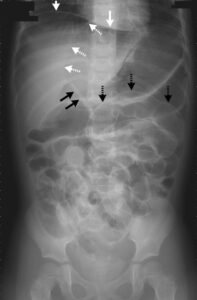This is an answer to the Case – Palpable, Ropelike Cord from the Left Medial Malleolus to the Groin
A 56-year-old woman began to have pain and redness of the left leg the day after a six-hour car ride. Two days later she was found to have erythema and tenderness on the medial aspect of the left knee and moderate pitting edema of the left ankle.
The remainder of the examination was unremarkable. She had no history of deep venous thrombosis. Both her parents, however, had a history of deep venous thrombosis.
Despite treatment with warm compresses, aspirin, and elevation of the leg, the pain and erythema increased. A palpable, ropelike cord was present from the left medial malleolus to the groin.
Duplex Doppler ultrasonography revealed thrombosis of the greater saphenous vein, with no extension into the deep venous system. Despite anticoagulation with heparin, a vague, substernal chest pain developed that was unrelieved by nitroglycerin.
Cardiac enzymes, electrocardiographic findings, and arterial blood gas levels remained normal. The results of ventilation–perfusion scanning were indeterminate for pulmonary embolism, and a pulmonary arteriogram was negative. Repeated duplex Doppler ultrasonography 5, 10, and 25 days after presentation showed no extension of the thrombus into the deep venous system.
Studies revealed that the patient had lupus anticoagulant, and a diagnosis of primary antiphospholipid-antibody syndrome was made. Other studies for thrombophilic tendencies, including tests for factor V Leiden and protein C and S deficiencies, were negative.
Two weeks after the initiation of treatment with warfarin, the international normalized ratio was 3.4 and the patient’s symptoms had resolved. Follow-up at three months showed no recurrence.

